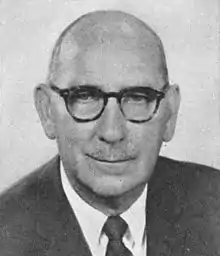Edward Alexander Garmatz | |
|---|---|
 | |
| Member of the U.S. House of Representatives from Maryland's 3rd district | |
| In office July 15, 1947 – January 3, 1973 | |
| Preceded by | Thomas D'Alesandro Jr. |
| Succeeded by | Paul Sarbanes |
| Chairman of the United States House Committee on Merchant Marine and Fisheries | |
| In office 1965-1973 | |
| Preceded by | Herbert Covington Bonner |
| Succeeded by | Leonor Sullivan |
| Personal details | |
| Born | February 7, 1903 Baltimore, Maryland |
| Died | July 22, 1986 (aged 83) Baltimore, Maryland |
| Political party | Democratic |
Edward Alexander Garmatz (February 7, 1903 – July 22, 1986), a Democrat, was a U.S. Congressman who represented the 3rd congressional district of Maryland from 1947 to 1973.
Early life and career
Born in Baltimore, Maryland; his father and maternal grandparents were German immigrants.[1] Garmatz attended the public schools, including the Baltimore Polytechnic Institute. He engaged in the electrical business from 1920 to 1942, and was associated with the Maryland State Racing Commission from 1941 to 1944. He served as police magistrate from 1944 to 1947.
Congressional Tenure
Garmatz was elected July 15, 1947, by special election to fill the vacancy left by Thomas D'Alesandro Jr., who had resigned the seat to become Mayor of Baltimore. He was re-elected to the twelve succeeding Congresses and served from July 15, 1947, to January 3, 1973. From the Eighty-ninth through the Ninety-second Congresses, Garmatz served as chairman of the Committee on Merchant Marine and Fisheries. Garmatz did not sign the 1956 Southern Manifesto, and voted in favor of the Civil Rights Acts of 1957,[2] 1960,[3] 1964,[4] and 1968,[5] as well as the 24th Amendment to the U.S. Constitution and the Voting Rights Act of 1965.[6][7]
Retirement
He was not a candidate for reelection in 1972 to the Ninety-third Congress, and became employed by the International Organization of Masters, Mates, and Pilots Union. He was a resident of Baltimore until his death there.
In 1978, a federal bribery conspiracy case against Garmatz was dismissed at the urging of Justice Department officials who said they had discovered that their key witness had lied to a grand jury and forged documents.[8] This information was brought to their attention through the investigation of Garmatz's attorney, Arnold M. Weiner.[9]
The federal courthouse in Baltimore is named after Garmatz. After his acquittal, Garmatz stood before the courthouse that bears his name, took out his handkerchief and began wiping the courthouse sign. When asked what he was doing he replied that he was wiping the tarnish from his name.[10]
References
- United States Congress. "Edward Garmatz (id: G000071)". Biographical Directory of the United States Congress.
- ↑ "United States Census, 1920", FamilySearch, retrieved March 14, 2018
- ↑ "HR 6127. CIVIL RIGHTS ACT OF 1957". GovTrack.us.
- ↑ "HR 8601. PASSAGE".
- ↑ "H.R. 7152. PASSAGE".
- ↑ "TO PASS H.R. 2516, A BILL TO ESTABLISH PENALTIES FOR INTERFERENCE WITH CIVIL RIGHTS. INTERFERENCE WITH A PERSON ENGAGED IN ONE OF THE 8 ACTIVITIES PROTECTED UNDER THIS BILL MUST BE RACIALLY MOTIVATED TO INCUR THE BILL'S PENALTIES".
- ↑ "S.J. RES. 29. CONSTITUTIONAL AMENDMENT TO BAN THE USE OF POLL TAX AS A REQUIREMENT FOR VOTING IN FEDERAL ELECTIONS". GovTrack.us.
- ↑ "TO PASS H.R. 6400, THE 1965 VOTING RIGHTS ACT".
- ↑ Becker, Elizabeth (January 10, 1978). "Garmatz Bribery Case Is Dropped". The Washington Post.
- ↑ Becker, Elizabeth (January 10, 1978). "Garmatz Bribery Case Is Dropped". The Washington Post.
- ↑ Glass, Andrew. "Rep. Edward Garmatz unveils a portrait of himself, Oct. 6, 1968". politico.com.
